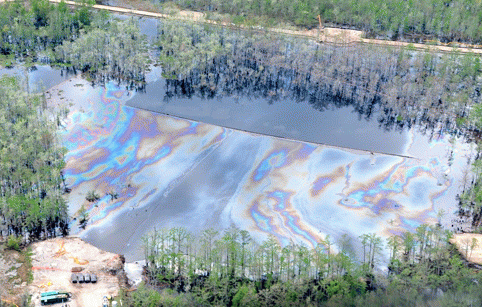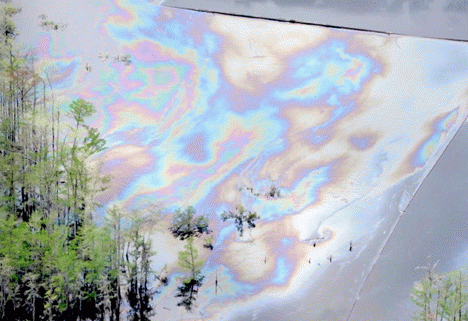This update is the 13th article in this Opednews series about the Bayou Corne sinkhole.
BACKGROUND: In Spring of 2012, Louisiana's Corne and Grand Bayou residents noticed strange bubbling in the bayou for many weeks, and they reported smelling burnt diesel fuel and sulfur. Then suddenly a sinkhole the size of three football fields appeared on Aug. 3, swallowing scores of 100-foot tall cypress trees. The sinkhole resulted from the failure of Texas Brine Company's abandoned underground brine cavern. The Department of Natural Resources issued a Declaration of Emergency on Aug. 6, and 150 families were evacuated.
For maps, diagrams and additional information, please see the twelve previous articles in this series, listed at the end of this article.
Environmental scientist Wilma Subra offers explanations about the explosive gases just discovered under slabs in the residential area near the sinkhole, as well as the oil slick which is clearly visible in the current sinkhole photos.
Subra is President of The Subra Company, and past Vice-Chair of the Environmental Protection Agency National Advisory Council for Environmental Policy and Technology (NACEPT). Her company provides technical assistance to citizens concerned with environmental issues, by combining technical research and evaluation.
MAB: Hello Wilma, thanks for taking time to answer some questions for us. On April 3, Assumption Parish officials reported that gas has been found under the slabs of two homes located on Sauce Piquante Lane, just a few hundred feet from the sinkhole. According to an interview on WAFB-TV, at least one of these homes has occupants.
Can you tell us what the presence of this gas indicates? Is it dangerous? What are the possibilities?
WS: Gas under the slabs of homes indicates that the gas floating on the aquifer underground has migrated to the surface under the homes as well as in the waters of Bayou Corne and Grand Bayou.
When gas is immediately under the slab of a house, it has the potential to migrate into the home through cracks in the slab, and around water, gas and sewer pipelines that go through the slab. The gas then becomes an explosive hazard for those living in the home.
MAB: The non-profit organization, On Wings of Care, released flyover photos on April 2 that show much more of the presence of an oily substance on the surface of the sinkhole waters than previously had been visible on the Assumption Parish Police Jury flyover photos.
Can you tell us a little about what this substance likely is, how it got there, and what it means for the residents and the environment?
WS: The oily substance seen floating on the surface of the sinkhole is crude oil that migrated into the sinkhole from oil production zones located around the salt dome. The crude oil migrated into the collapsed cavern and then into the sinkhole. When the crude oil is present on the surface of the sinkhole the air emissions in the community are increased and result in health impacts being experienced by the community when they return to check on their homes.
MAB: Thank you, Wilma, for answering questions once again!
(Note: You can view every article as one long page if you sign up as an Advocate Member, or higher).







